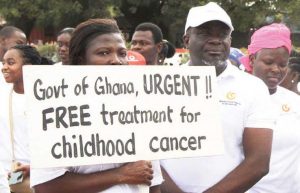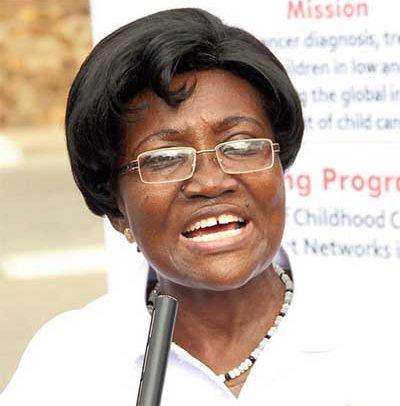Prof. Lorna Awo Renner
Latifa was just three years old when she developed eye cancer.
Her family first noticed that something was wrong when a white spot appeared in her eye while at a village in northern Ghana.
When traditional medicines and eye drops failed to work, Latifa’s parents took her to the eye clinic at Komfo Anokye Teaching Hospital (KATH) in Kumasi, where she underwent a surgery.
The surgery cost Latifa’s family two months’ income, leaving them under severe financial pressure.
Without enough money to pay for the chemotherapy, they were forced to return home.
Soon after, the tumour returned. The family eventually managed to raise money for further treatment and Latifa made the 17-hour journey to Korle-Bu Teaching Hospital (KBTH) in Accra with her mother and two siblings.
Unfortunately, the treatment came too late… but it did not have to be this way because childhood cancers can be cured in Ghana with early detection and treatment.
About 70 per cent of children with cancer in Ghana lose their lives, with the number of cases diagnosed in Ghana increasing each year.
Around 1,300 new cases of childhood cancer are expected in Ghana each year, however, only Korle-Bu and Komfo Anokye Teaching Hospitals provide cancer treatment to the few fortunate ones who get access to these tertiary treatment centres.
As access to healthcare services is limited to majority of Ghanaians, there remain a large number of children who are currently not diagnosed.
“We only see about 300 yearly combined in the only two comprehensive centres, KBTH and KATH with only five paediatric oncologists.
What happens to the remaining 70 per cent of affected children? Prof. Lorna Awo Renner, head of the Paediatric Oncology Unit, KBTH, indicated.
The sad thing, Prof. Renner observed, is that about 80 per cent of children with cancer can be cured and live productive lives if they get access to treatment early.
Success Story
Charlotte is a single mother of two who had gone through a lot in the past 18 months. Her oldest daughter, Rebecca, developed cancer. In fact, it was the mere mention of the word ‘cancer’ that struck fear into her most.
“I was scared that I might lose my child but the doctors encouraged me that Rebecca’s cancer was treatable and that she had a chance to be healthy again,” she added.
Rebecca visited several healthcare workers, got treated for both malaria and typhoid, before eventually being diagnosed with cancer. As any mother would do for her child, Charlotte finds it difficult to see the changes in her daughter caused by the treatment.
“The thing that made me sad was her hair loss. That touched me a lot, but I know the only thing that matters is that she makes it that she won’t die from cancer. After the second round of chemo, the doctor looked happy and told me she is responding to the treatment and all will be well,” Charlotte revealed.
Being away from her home and her youngest daughter was difficult.
Charlotte stayed in Accra during Rebecca’s treatment whilst her own mother took care of her youngest daughter at home. One of her biggest worries was not having enough money; luckily Charlotte was fortunate to find a sponsor to pay for Rebecca’s treatment.
“I work hard to take care of my two children but it’s very hard because I left my youngest child with my mother. Rebecca’s father is in Nigeria and doesn’t want to support us with her treatment.
The staff here have been helpful, they have taught us to make bead jeweler, which I am doing to support us,” Charlotte indicated.
Cost of Treatment
It is common to attribute headache and vomiting to other causes or even ignore them as tension headaches until they become persistent and or severe.
Prof. Renner explained that cancers may present without any pain; thus, painless swellings, unexplained bleeding, unprovoked bruising, headaches and vomiting, especially in the early hours of the day, protracted fever, especially not responding to usual treatment; white spots in the eye of babies and children and unexplained weight loss must be immediately reported to healthcare practitioners who should investigate appropriately.
She said the commonest cancers in children include eye, kidney and lymphomas, which cost about GH¢4,000 for the entire treatment cycle of between four and eight months, while others, especially leukaemia, could cost up to GH¢25,000 for treatment of about three years.
“A diagnosis of childhood cancer dramatically changes the dynamics of any family. The responsibility for ensuring cure should be shared by all, including government, private sector, non-governmental and religious organisations, philanthropists, parents and healthcare professionals,” Prof. Renner stated.
According to her, the cost involved in seeking treatment for a child with cancer has not only left some families bankrupt, but some have lost their assets, while others have gone deeper into poverty.
“No family should ever have to choose between putting food on the table, sending a child to school or seeking treatment for a child with cancer. Unfortunately, because of the catastrophic cost of childhood cancer treatment and medicines, these are the choice families with children with cancer have to make in lower middle income countries like Ghana,” she opined.
However, the abandonment rates of the treatment are high, as childhood cancer treatment is not covered by the country’s health insurance scheme and costs are prohibitive for families.
Giving an example of a typical case of childhood cancer, Prof. Renner revealed that a boy from the north of Ghana was referred to KBTH with a swelling right eye, which was diagnosed as retinoblastoma.
“His family had the health insurance and GH¢1000 but the treatment totalled GH¢6,700, excluding costs covered by NHIS and other living expenses,” she added.
She, therefore, advocated for the Health Insurance Scheme (NHIS) to lift the financial burden off parents and save the children from dying.
“At least, some of the selected childhood cancers that are quite curable should be added to the NHIS list so I passionately appeal to policymakers to take steps to do this,” she said.
Lifeline For Childhood Cancer In Ghana (LCCG)
In order to mobilise financial support for families with children with cancer, a non-governmental organisation with the vision of ensuring that every child diagnosed with cancer in Ghana will get the treatment they need, has been launched.
The Lifeline for Childhood Cancer in Ghana (LCCG) has a vision of ensuring that no matter where they live in Ghana, families with such children will get the support, both financially and emotionally, that they need for timely diagnosis and treatment,.
“Our mission is to optimise access to the best possible care for all children affected by cancer in Ghana, ensuring that no such child suffers needlessly,” Dr. William Panford Bray Board Chair of the LCCG, said.
“I want to call on all individuals, organisations and stakeholders to join this initiative so that we can give a lifeline to children,” he added.
Dr. Panford Bray emphasized the need for awareness creation, early diagnosis and access to treatment as the way forward to dealing with childhood cancer.
The Ghana Childhood Cancer Network (GCCN), in collaboration with the Paediatric Society of Ghana, has also called on policymakers to include the cost of treatment of childhood cancers in the National Health Insurance Scheme (NHIS).
It indicated that the cost of treatment for childhood cancer remained high “as everything, including anticancer drugs, supportive care and hospital admissions are still completely borne by parents.”

Ghana Cancer Network calling for free treatment for children
Childhood Cancer Awareness Month
September is Childhood Cancer Awareness Month and stakeholders are calling for all to join hands in advocating and supporting the move to ensure that no child affected by cancer in Ghana suffers needlessly.
“We are calling on policymakers to include childhood cancers on the NHIS, include screening for eye cancer at child weighing clinics, support childhood cancer awareness creation activities nationwide and facilitate capacity building in all aspects of care,” the GCCN added.
It pointed out that every child has the right to equity in accessing quality healthcare in Ghana and to achieving a full life.
“We stand the best chance of curing childhood cancers when they are diagnosed early, when patients with suspected cancer present early to our referral centres,” it stressed.
PULL OUT
THE GOLD RIBBON
In 1997, a small group of parents in the United States of America started discussing the need for a universal symbol to create awareness of childhood cancer and mobilise increased attention for minimising deaths and disabilities due to childhood cancer.
They chose gold ribbon because gold is a precious metal, so are children.
Gold is also a perfect symbol for the childhood cancer journey.
Gold goes through a process by fire to become stronger and tougher, and so do children with childhood cancer.
They often develop resiliency by facing all the difficult and painful challenges of childhood cancer.
Since then, the gold ribbon has crossed continents and been used around the world.
Diverse organisations have used the gold bibbon symbol in expressing support and generating solidarity for the FIGHT against childhood cancer.
However, it has not yet reached the peak prominence that the pink ribbon of breast cancer and the red ribbon of HIV AIDS has reached.
The Gold Ribbon Campaign
This aims to raise awareness and visibility worldwide of the gold ribbon.
It encourages people and organisations to maximise the use of the gold ribbon to show their support for the fight against childhood cancer.
The display of the gold ribbon will INSPIRE and boost the HOPE of children/adolescents with cancer, the survivors and their families.
The ‘Gold Ribbon Campaign’ is for the HEROES within our midst.
The children and adolescents who bravely and courageously fight cancer; yhe survivors who beat cancer; the families who fearlessly live with the realities of cancer and with the loss of a precious child and volunteers, staff and medical practitioners who passionately serve and dedicate their time to the childhood cancer community.
Jamila Akweley Okertchiri


